Bilateral Change in Vertical Hoof Force Distribution in Horses with Unilateral Forelimb Lameness before and after Successful Diagnostic Anaesthesia
Abstract
:Simple Summary
Abstract
1. Introduction
- 1.
- Before diagnostic anaesthesia
- (a)
- Vertical force in kilograms on the lame limb is reduced compared to the sound limb during all parts of the stance phase (landing, midstance, breakover).
- 2.
- After positive diagnostic anaesthesia
- (a)
- Vertical force on the anaesthetised limb increases whereas the vertical force on the sound limb decreases, which leads to a more symmetrical bilateral vertical force distribution in kilograms during all parts of the stance phase (landing, midstance, breakover).
- (b)
- Following diagnostic anaesthesia, the maximum increase in vertical force on the lame limb occurs during midstance.
2. Materials and Methods
2.1. Horses
2.2. Data Collection
2.3. Data Analysis
3. Results
3.1. ANCOVA
3.2. Pairwise Comparisons
3.2.1. Before Diagnostic Anaesthesia
3.2.2. After Diagnostic Anaesthesia
3.2.3. Lame Limb before and after Anaesthesia
3.2.4. Sound Limb before and after Anaesthesia
4. Discussion
5. Conclusions
Author Contributions
Funding
Institutional Review Board Statement
Informed Consent Statement
Data Availability Statement
Acknowledgments
Conflicts of Interest
References
- Arkell, M.; Archer, R.; Guitian, F.; May, S. Evidence of bias affecting the interpretation of the results of local anaesthetic nerve blocks when assessing lameness in horses. Vet. Rec. 2006, 159, 346–349. [Google Scholar] [CrossRef]
- Keegan, K.G.; Dent, E.V.; Wilson, D.A.; Janicek, J.; Kramer, J.; Lacarrubba, A.; Walsh, D.M.; Cassells, M.W.; Esther, T.M.; Schiltz, P.; et al. Repeatability of subjective evaluation of lameness in horses. Equine Vet. J. 2010, 42, 92–97. [Google Scholar] [CrossRef]
- Dyson, S. Can lameness be graded reliably? Equine Vet. J. 2011, 43, 379–382. [Google Scholar] [CrossRef] [PubMed]
- Fuller, C.J.; Bladon, M.B.; Driver, A.J.; Barr, A.R.S. The intra- and inter-assessor reliability of measurement of functional outcome by lameness scoring in horses. Vet. J. 2006, 171, 281–286. [Google Scholar] [CrossRef]
- Hewetson, M.; Christley, R.M.; Hunt, I.D.; Voute, L.C. Investigations of the reliability of observational gait analysis for the assessment of lameness in horses. Vet. Rec. 2006, 158, 852–857. [Google Scholar] [CrossRef] [PubMed]
- Keegan, K.G.; Kramer, J.; Yonezawa, Y.; Maki, H.; Frank Pai, P.; Dent, E.V.; Kellermann, T.E.; Wilson, D.A.; Reed, S.K. Assessment of repeatability of a wireless, inertial sensor-based lameness evaluation system for horses. Am. J. Vet. Res. 2011, 72, 1156–1163. [Google Scholar] [CrossRef] [PubMed]
- Reed, S.K.; Kramer, J.; Thombs, L.; Pitts, J.B.; Wilson, D.A.; Keegan, K.G. Comparison of results for body-mounted inertial sensor assessment with final lameness determination in 1.224 equids. J. Am. Vet. Med. Assoc. 2020, 256, 590–599. [Google Scholar] [CrossRef]
- Bosch, S.; Braganca, F.S.; Marin-Perianu, M.; Marin-Perianu, R.; van der Zwaag, B.J.; Voskamp, J.; Back, W.; van Weeren, R.; Havinga, P. EquiMoves: A wireless networked inertial measurement system for objective examination of horse gait. Sensors 2018, 18, 850. [Google Scholar] [CrossRef]
- McCracken, M.J.; Kramer, J.; Keegan, K.G.; Lopes, M.; Wilson, D.A.; Reed, S.K.; LaCarrubba, A.; Rasch, M. Comparison of an inertial sensor system of lameness quantification with subjective lameness evaluation. Equine Vet. J. 2012, 44, 652–656. [Google Scholar] [CrossRef]
- Oosterlinck, M.; Pille, F.; Huppes, T.; Gasthuys, F.; Back, W. Comparison of pressure plate and force plate gait kinetics in sound Warmbloods at walk and trot. Vet. J. 2010, 186, 347–351. [Google Scholar] [CrossRef]
- Oosterlinck, M.; Pille, F.; Back, W.; Dewulf, J.; Gasthuys, F. Use of a stand-alone pressure plate for the objective evaluation of forelimb symmetry in sound ponies at walk and trot. Vet. J. 2010, 183, 305–309. [Google Scholar] [CrossRef] [PubMed]
- Serra Braganca, F.M.; Hernlund, E.; Thomsen, M.H.; Waldern, N.M.; Rhodin, M.; Byström, A.; van Weeren, P.R.; Weishaupt, M.A. Adaptation strategies of horses with induced forelimb lameness walking on a treadmill. Equine Vet. J. 2021, 53, 600–611. [Google Scholar] [CrossRef] [PubMed]
- Weishaupt, M.A.; Wiestner, T.; Hogg, H.P.; Jordan, P.; Auer, J.A. Compensatory load redistribution of horses with induced weight-bearing forelimb lameness trotting on a treadmill. Vet. J. 2006, 171, 135–146. [Google Scholar] [CrossRef] [PubMed]
- Merkens, H.W.; Schamhardt, H.C. Evaluation of equine locomotion during different degrees of experimentally induced lameness. I: Lameness model and quantification of ground reaction force patterns of the limbs. Equine Vet. J. 1988, 20, 99–106. [Google Scholar] [CrossRef]
- Van de Water, E.; Oosterlinck, M.; Pille, F. The effect of perineural anaesthesia and handler position on limb loading and hoof balance of the vertical ground reaction force in sound horses. Equine Vet. J. 2016, 48, 608–612. [Google Scholar] [CrossRef]
- Keg, P.R.; Schamhardt, H.C.; van Weeren, P.R.; Barneveld, A. The effect of diagnostic regional nerve blocks in the fore limb on the locomotion of clinically sound horses. Vet. Q. 1996, 18 (Suppl. 2), 106–109. [Google Scholar] [CrossRef]
- Bidwell, L.A.; Brown, K.E.; Cordier, A.; Mullineaux, D.R.; Clayton, H.M. Mepivacaine local anaesthetic duration in equine palmar digital nerve blocks. Equine Vet. J. 2004, 36, 723–726. [Google Scholar] [CrossRef]
- Lange, C.; Kattelans, A.; Rohn, K.; Lüpke, M.; Brückner, H.-P.; Stadler, P. Kinetic examination of initial hoof contact, load distribution and break-over in the forelimbs of horses. Pferdeheilkunde 2012, 28, 538–547. [Google Scholar] [CrossRef]
- Hüppler, M.; Hagen, J.; Häfner, F.S.; Geiger, S.M.; Mäder, D. Examination of the pressure force distribution affecting the hoof and its influenceability by different ground properties. Pferdeheilkunde 2015, 31, 426–434. [Google Scholar] [CrossRef]
- Tijssen, M.; Hernlund, E.; Rhodin, M.; Bosch, S.; Voskamp, J.P.; Nielen, M.; Serra Braganca, F.M. Automatic detection of break-over phase onset in horses using hoof-mounted inertial measurement unit sensors. PLoS ONE 2020, 15, e0233649. [Google Scholar]
- Al Naem, M.; Litzke, L.-F.; Failing, K.; Burk, J.; Röcken, M. Hoof kinetic patterns differ between sound and laminitic horses. Equine Vet. J. 2021, 53, 503–509. [Google Scholar] [CrossRef] [PubMed]
- Perino, V.V.; Kawcak, C.E.; Frisbie, D.D.; Reiser, R.F.; McIlwraith, C.W. The Accuracy and Precision of an Equine In-Shoe Pressure Measurement System as a Tool for Gait Analysis. J. Equine Vet. Sci. 2007, 27, 161–166. [Google Scholar] [CrossRef]
- Schumacher, J.; Schramme, M.C.; Schumacher, J.; DeGraves, F.J. Review Article: Diagnostic analgesia of the equine digit. Equine Vet. Educ. 2013, 25, 408–421. [Google Scholar] [CrossRef]
- Schumacher, J.; Schumacher, J.; Schramme, M.C.; DeGraves, F.J.; Smith, R.; Coker, M. Tutorial Article: Diagnostic analgesia of the equine forefoot. Equine Vet. Educ. 2004, 16, 159–165. [Google Scholar] [CrossRef]
- Clayton, H.M.; Schamhardt, H.C. Measurement techniques for gait analysis. In Equine Locomotion; Back, W., Clayton, H.M., Eds.; SaundersL: Philadelphia, PA, USA; London, UK, 2001; pp. 55–76. [Google Scholar]
- Lange, C. Examination of a Hoof Pressure Measurement System Combined with Three Dimensional, High-Frequency Video Recordings for Equine Gait Analysis. Dr. med. vet. Thesis. University of Veterinary Medicine Hannover, Hannover, Germany, 2011; pp. 21–23. [Google Scholar]
- Barrey, E.; Landjerit, B.; Wolter, R. Shock and vibration during the hoof impact on different track surfaces. Equine Exerc. Physiol. 1991, 3, 97–106. [Google Scholar]
- Clayton, H.M.; Lanovaz, J.L.; Schamhardt, H.C.; Willemen, M.A.; Colborne, G.R. Net joint moments and powers in the equine forelimb during the stance phase of the trot. Equine Vet. J. 1998, 30, 384–389. [Google Scholar] [CrossRef]
- Page, B.; Hagen, T. Breakover of the hoof and its effect on structures and forces within the foot. J. Equine Vet. Sci. 2002, 22, 258–264. [Google Scholar] [CrossRef]
- Clayton, H.M. Comparison of the stride of trotting horses trimmed with a normal and a broken back hoof axis. In Proceedings of the 7th American Association of Equine Practitioners, New Orleans, LA, USA, 29 November–02 December 1987; pp. 289–298. [Google Scholar]
- Clayton, H.M.; Sigafoos, R.; Curle, R.D. Effect of the three shoe types on the duration of breakover in sound trotting horses. J. Equine Vet. Sci. 1990, 11, 129–132. [Google Scholar] [CrossRef]
- Thomason, J.J.; Peterson, M.L. Biomechanical and Mechanical Investigations of the Hoof-Track interface in Racing Horses. Vet. Clin. N. Am. Equine Pract. 2008, 24, 53–77. [Google Scholar] [CrossRef]
- Keegan, K.G.; Wilson, D.A.; Kramer, J.; Reed, S.K.; Yonezawa, Y.; Maki, H.; Pai, P.F.; Lopes, M.A.F. Comparison of a body-mounted inertial sensor system-based method with subjective evaluation for detection of lameness in horses. Am. J. Vet. Res. 2013, 74, 17–24. [Google Scholar] [CrossRef]
- Al Naem, M.; Litzke, L.-F.; Geburek, F.; Failing, K.; Hoffmann, J.; Röcken, M. Effect of heel elevation on breakover phase in horses with laminitis. BMC Vet. Res. 2020, 16, 370. [Google Scholar] [CrossRef] [PubMed]
- Drevemo, S.; Johnston, C.; Roepstorff, L.; Gustås, P. Nerve block and intra-articular anaesthesia of the forelimb in the sound horse. Equine Vet. J. 1999, 31 (Suppl. 30), 266–269. [Google Scholar] [CrossRef] [PubMed]
- Rehren, K.D. “Crookedness” in the Horse: Symmetry of Motion and Hoof Loading. Dr. med. vet. Thesis. University of Veterinary Medicine Hannover, Hannover, Germany, 2018. [Google Scholar]
- Weishaupt, M.A. Adaptation strategies of Horses with Lameness. Vet. Clin. N. Am. Equine Pract. 2008, 24, 79–100. [Google Scholar] [CrossRef]
- Logan, A.A.; Nielsen, B.D.; Hallock, D.B.; Robison, C.I.; Popovich, J.M., Jr. Evaluation of Within- and Between- Session Reliability of the TekscanTM Hoof System With a Glue-on Shoe. J. Equine Vet. Sci. 2022, 110, 103862. [Google Scholar] [CrossRef]
- Jansson, K.S.; Michalski, M.P.; Smith, S.D.; LaPrade, R.F.; Wijdicks, C.A. Tekscan pressure sensor output changes in the presence of liquid exposure. J Biomech. 2013, 46, 612–614. [Google Scholar] [CrossRef]
- Weishaupt, M.A.; Hogg, H.P.; Auer, J.A.; Wiestner, T. Velocity-dependent changes of time, force and spatial parameters in Warmblood horses walking and trotting on a treadmill. Equine Vet. J. 2010, 42, 530–537. [Google Scholar] [CrossRef] [PubMed]
- Starke, S.D.; Raistrick, K.J.; May, S.A.; Pfau, T. The effect of trotting speed on the evaluation of subtle lameness in horses. Vet. J. 2013, 197, 245–252. [Google Scholar] [CrossRef]
- Peham, C.; Licka, T.; Mayr, A.; Scheidl, M. Individual speed dependency of forelimb lameness in trotting horses. Vet. J. 2000, 160, 135–138. [Google Scholar] [CrossRef]
- Degueurce, C.; Pourcelot, P.; Audigié, F.; Denoix, J.M.; Geiger, D. Variability of the limb joint patterns of sound horses at trot. Equine Vet. J. 1997, 29 (Suppl. 23), 89–92. [Google Scholar] [CrossRef]
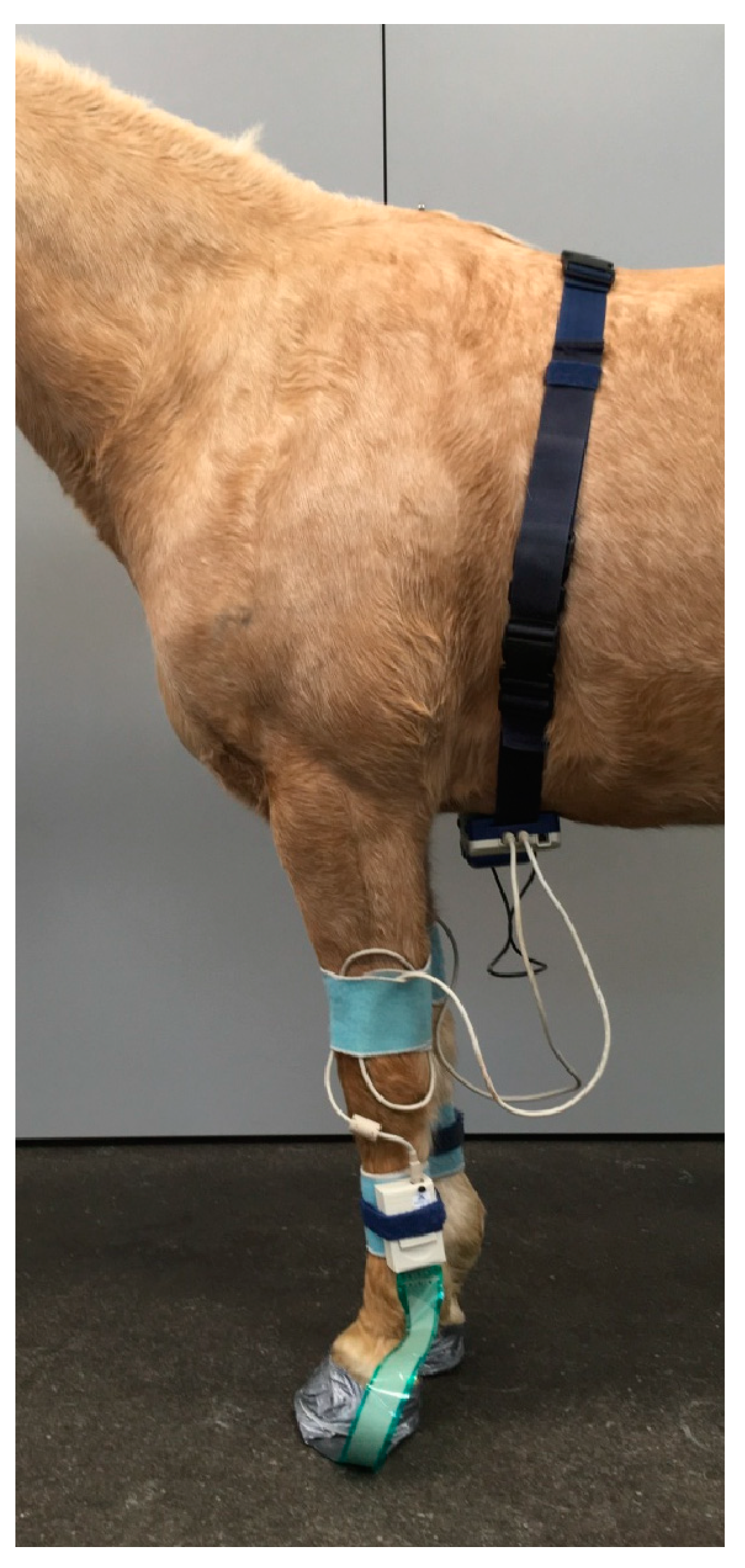
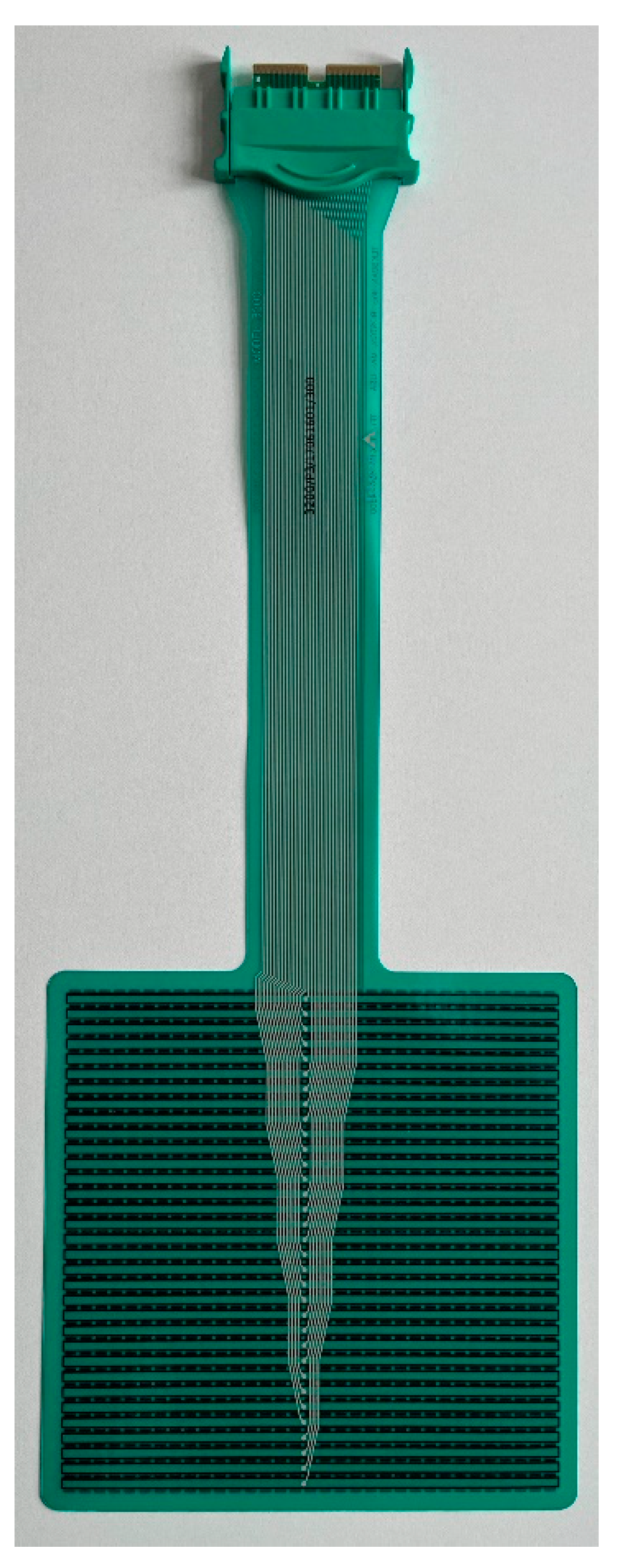
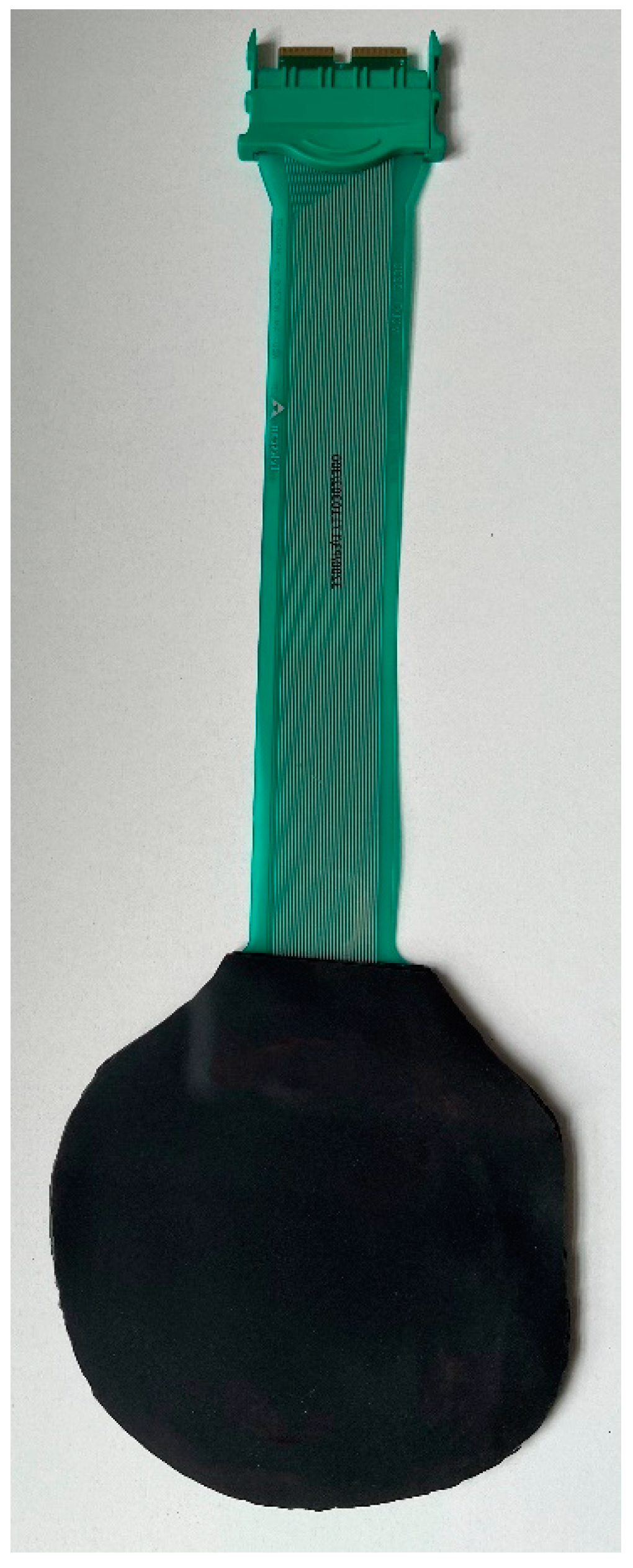

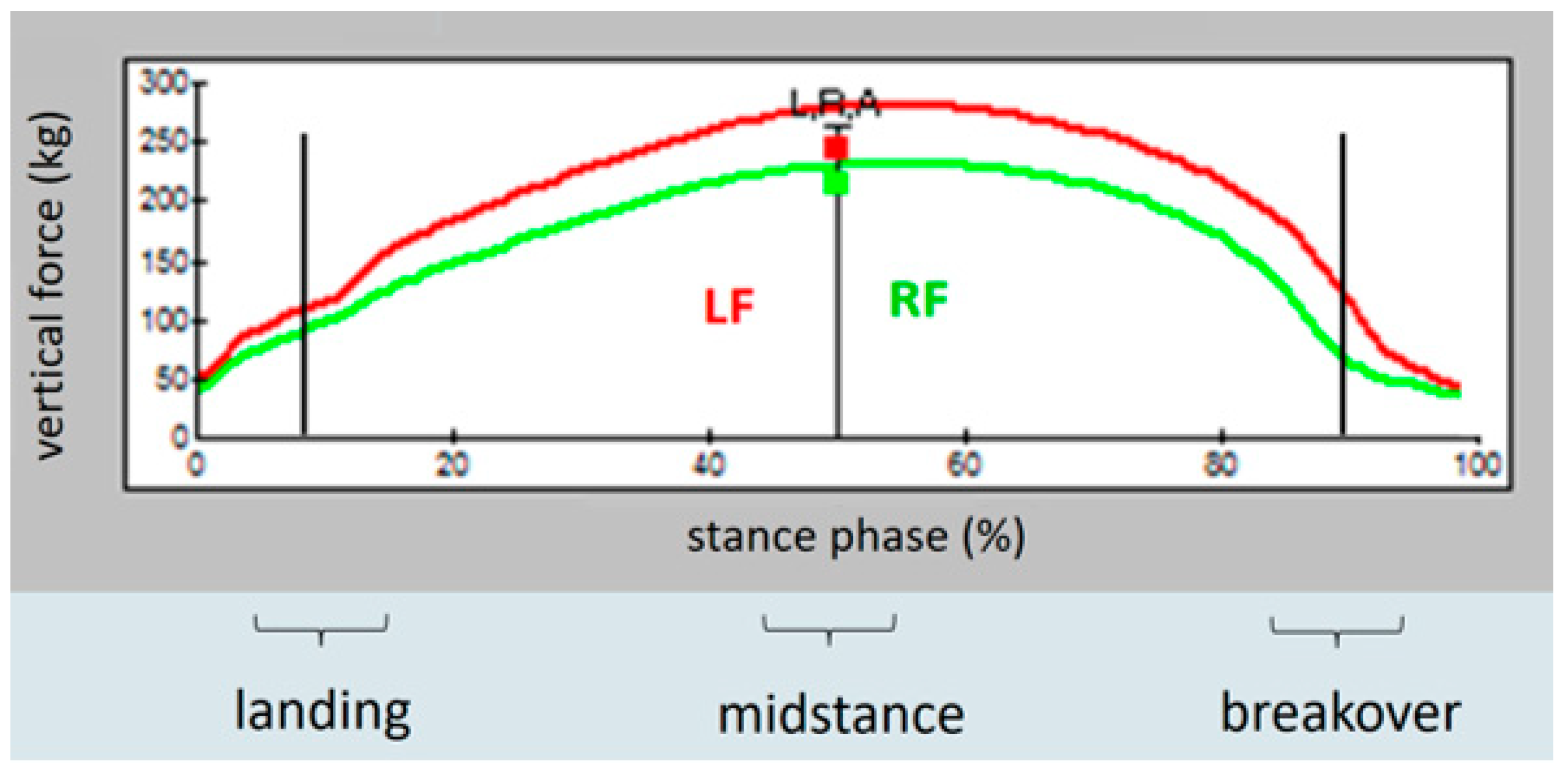
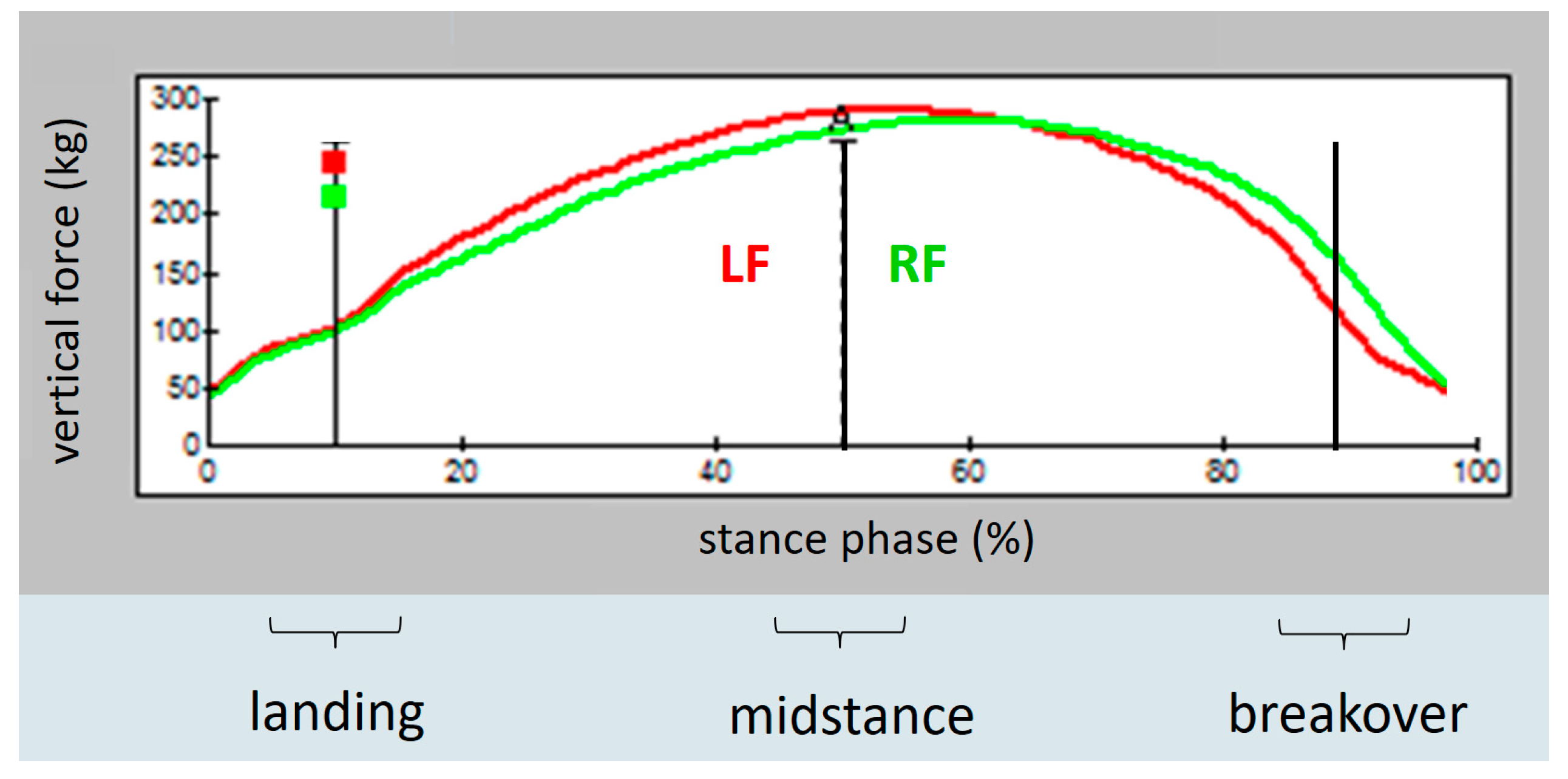
| Breed | Age (Mean ± SD) | Weight (Mean ± SD) | Shod | Unshod |
|---|---|---|---|---|
| 8 German Warmblood horses | 12 ± 6 years | 560 ± 50 kg | 4 * | 4 |
| 2 Icelandic horses | 10 ± 5 years | 350 ± 50 kg | 0 | 2 |
| 2 Cold bloods | 15 ± 2 years | 650 ± 50 kg | 2 † | 0 |
| 1 Appaloosa | 16 years | 500 kg | 1 † | 0 |
| 1 Arabian horse | 22 years | 400 kg | 0 | 1 |
| Lame Limb | Lameness Score | Location of Anaesthesia | Type of Anaesthesia | Result of Anaesthesia | |
|---|---|---|---|---|---|
| Warmbloods | |||||
| 1 | RF | 2 | antebrachiocarpal joint | intrasynovial | positive |
| 2 | LF | 2 | digital flexor tendon sheath | intrasynovial | positive with slight rest |
| 3 | RF | 3.5 | abaxial sesamoid | perineural | positive with lameness on the contralateral limb |
| 4 | RF | 3 | abaxial sesamoid | perineural | positive with slight rest |
| 5 | RF | 2 | abaxial sesamoid | perineural | positive with slight rest |
| 6 | LF | 2 | abaxial sesamoid | perineural | positive |
| 7 | RF | 2 | abaxial sesamoid | perineural | positive |
| 8 | RF | 3 | medial collateral ligament (elbow joint) | infiltration | positive with distinct rest |
| Icelandic horses | |||||
| 9 | LF | 1 | high 4 point | perineural | positive with slight rest |
| 10 | LF | 2 | low palmar digital | perineural | positive |
| Cold bloods | |||||
| 11 | RF | 2 | high palmar digital | perineural | positive with lameness on the contralateral limb |
| 12 | RF | 3 | low 4 point | perineural | positive with slight rest |
| Appaloosa | |||||
| 13 | RF | 2 | abaxial sesamoid | perineural | positive with slight rest |
| Arabian horse | |||||
| 14 | RF | 3.5 | antebrachiocarpal joint | intrasynovial | positive with slight rest |
| Landing | Midstance | Breakover | |
|---|---|---|---|
| Impact of body weight | p = 0.001 | p < 0.001 | p = 0.02 |
| Impact of limb (lame/sound) | p = 0.008 | p = 0.003 | p = 0.02 |
| Impact of anaesthesia (before/after) | p = 0.6 | p = 0.2 | p = 0.5 |
| Interaction between limb and anaesthesia | p = 0.003 | p < 0.001 | p < 0.001 |
| Lame Limb | Sound Limb | p-Value | |
|---|---|---|---|
| Landing | 111 ± 28 kg | 147 ± 45 kg | <0.001 |
| Midstance | 265 ± 75 kg | 332 ± 110 kg | <0.001 |
| Breakover | 135 ± 71 kg | 185 ± 87 kg | <0.001 |
| Lame Limb | Sound Limb | p-Value | |
|---|---|---|---|
| Landing | 127 ± 34 kg | 136 ± 35 kg | 0.1 |
| Midstance | 307 ± 76 kg | 318 ± 79 kg | 0.3 |
| Breakover | 170 ± 73 kg | 162 ± 63 kg | 0.3 |
| Lame Limb: Vertical Force before Anaesthesia | Lame Limb: Vertical Force after Anaesthesia | p-Value | |
|---|---|---|---|
| Landing | 111 ± 28 kg | 127 ± 34 kg | 0.009 |
| Midstance | 265 ± 75 kg | 307 ± 76 kg | <0.001 |
| Breakover | 135 ± 71 kg | 170 ± 73 kg | 0.001 |
| Sound Limb: Vertical Force before Anaesthesia | Sound Limb: Vertical Force after Anaesthesia | p-Value | |
|---|---|---|---|
| Landing | 147 ± 45 kg | 136 ± 35 kg | 0.06 |
| Midstance | 332 ± 110 kg | 318 ± 79 kg | 0.1 |
| Breakover | 185 ± 87 kg | 162 ± 63 kg | 0.02 |
Publisher’s Note: MDPI stays neutral with regard to jurisdictional claims in published maps and institutional affiliations. |
© 2022 by the authors. Licensee MDPI, Basel, Switzerland. This article is an open access article distributed under the terms and conditions of the Creative Commons Attribution (CC BY) license (https://creativecommons.org/licenses/by/4.0/).
Share and Cite
Hoffmann, J.R.; Geburek, F.; Hagen, J.; Büttner, K.; Cruz, A.M.; Röcken, M. Bilateral Change in Vertical Hoof Force Distribution in Horses with Unilateral Forelimb Lameness before and after Successful Diagnostic Anaesthesia. Animals 2022, 12, 2485. https://doi.org/10.3390/ani12182485
Hoffmann JR, Geburek F, Hagen J, Büttner K, Cruz AM, Röcken M. Bilateral Change in Vertical Hoof Force Distribution in Horses with Unilateral Forelimb Lameness before and after Successful Diagnostic Anaesthesia. Animals. 2022; 12(18):2485. https://doi.org/10.3390/ani12182485
Chicago/Turabian StyleHoffmann, Johanna R., Florian Geburek, Jenny Hagen, Kathrin Büttner, Antonio M. Cruz, and Michael Röcken. 2022. "Bilateral Change in Vertical Hoof Force Distribution in Horses with Unilateral Forelimb Lameness before and after Successful Diagnostic Anaesthesia" Animals 12, no. 18: 2485. https://doi.org/10.3390/ani12182485
APA StyleHoffmann, J. R., Geburek, F., Hagen, J., Büttner, K., Cruz, A. M., & Röcken, M. (2022). Bilateral Change in Vertical Hoof Force Distribution in Horses with Unilateral Forelimb Lameness before and after Successful Diagnostic Anaesthesia. Animals, 12(18), 2485. https://doi.org/10.3390/ani12182485





